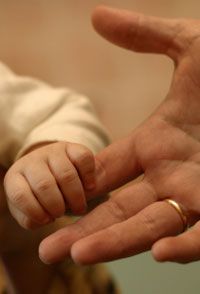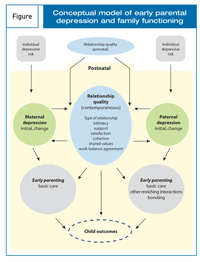Focusing on Depression in Expectant and New Fathers
This article reviews the limited but growing literature about prenatal and postpartum depression in fathers.

Significant depression affects between 10% and 30% of women during pregnancy: the incidence remains elevated in the year following childbirth.1,2 Although a large body of research has documented the risk factors for and negative effects of depression in mothers, little is known about depression in expectant or new fathers.3
This article reviews the limited but growing literature about prenatal and postpartum depression in fathers. It highlights recent findings, identifies areas for future research, and suggests a preliminary conceptual framework that emphasizes the co-parental relationship. The goal is to improve our understanding of relational factors that may underlie depression in new fathers.
Does childbirth-associated depression affect fathers?
Depression during pregnancy and following childbirth has been historically regarded as a phenomenon that affects only women.2,4 The popular press as well as medical and mental health providers emphasize the causative role of biochemical changes that the mother experiences during pregnancy and following birth. Endocrine and biochemical theories of childbirth-associated depression in women, despite their popularity, are supported by a fragmented literature that inconsistently identifies hormonal causes and insufficiently replicates hormone-depression correlations.5
CHECKPOINTS
? The quantity and quality of the father’s involvement with his infant or toddler predicts child developmental outcomes. Paternal depression in early childhood may convey developmental and psychological risks to the child.
? The incidence of significant depression among new fathers has been estimated to be between 1.2% and 25.5%.
? Growing evidence suggests that paternal depressive symptoms are predicted by interpersonal problems with the mother and maternal depressive symptoms.
Psychosocial theories of prenatal and postpartum depression place the causal focus on stresses in the mother that are triggered by relational disturbances (eg, gender role demands, unsatisfied attachment needs, disruptions in interpersonal relationships, perceived dissonance with social norms).6 Research on psychosocial factors has been relatively fruitful and has identified significant predictors of depression that include life stress, lack of social support, a difficult marital relationship, socioeconomic status, and many other psychological, familial, and social predictors.7-10
It is unclear why depression in new and expectant fathers has not been examined until recently. The popular tendency to focus on biological changes that surround the pregnancy as causal factors may have contributed to overlooking the nonpregnant parent. Fathers (who are not directly susceptible to childbirth-related biochemical changes) are subject to psychosocial stressors that accompany new parenthood and, therefore, they may experience distress uniquely tied to their new role. The quantity and quality of the father’s involvement with his infant or toddler has been demonstrated to predict child developmental outcomes. Paternal depression during a child’s early years may convey developmental and psychological risks to the child.11,12
A number of recent studies have documented that depression in new fathers is both prevalent (ie, the incidence is higher than in the general adult male population) and associated with negative outcomes for the offspring. In the months following childbirth, the incidence of significant depression among fathers has been estimated to be between 1.2% and 25.5%.13-15 This budding field of research is not without growing pains, and the wide range of incidence estimates is a clear signal of this. Methods for measuring depression in new and expectant fathers have yet to reach consistency among researchers. We remain far from a consensus on such issues as:
• When to measure (during pregnancy and/or after the birth of the child)?
• How to identify which fathers to include?
• How to sort out subgrouping is-sues (eg, resident vs nonresident fathers)?
We still lack the terminology even to describe the phenomenon (eg, male postpartum depression or early fatherhood depression).
The wide variance in methods used to study early fatherhood depression is a probable cause of the variable prevalence estimates that have been reported by Goodman, Pinheiro, myself, and others.13-15 Despite these challenges, however, it has become clear that depression in expectant and new fathers is more common than we once believed.
Consequences of depression
Depression in new mothers is a major concern because it negatively affects the child’s development and mental health outcomes.3 Little is known about the effect of a father’s depression on the child. However, a number of studies suggest that paternal depression does present a risk to healthy child development. A 2005 study found that increases in paternal depression symptoms measured at 8 weeks’ postpartum were associated with increased child internalizing and externalizing behavior problems at 3.5 years. This effect, which was stronger in boys, was observed in children even when paternal depression had diminished.16 Other findings suggest that depression in fathers of infants is associated with reduced father-child activ-ities, impaired father-child bonding, increased parenting stress, and greater discord in the relationship with the child’s mother.17,18 In several studies, subclinical elevations in depressive symptoms were associated with negative effects on parenting and negative consequences on child functioning.15,19
A study undertaken by me and my colleagues found that 9-month-old children of depressed fathers experienced a reduction in positive parent-child interactions (including playing, singing songs, telling stories, and reading).15 New findings suggest that this reduction in father-child interaction, particularly with respect to reading, negatively affects child expressive vocabulary at 2 years of age.19 Moreover, depression among nonresident parents has a negative effect on the parental relationship and subsequently reduces the involvement of the nonresident father with his infant.15,19
Relational dynamics
Factors that cause or contribute to depression in new fathers are poorly understood. As with depressive risk in general, a history of depression and other mental illness appears to be a strong predictor of postnatal depression in both fathers and mothers.20 Although family structural characteristics (such as separation, divorce, or stepfamily status) appear to be risks for greater depression, specific proximal mechanisms leading to early paternal depression are unclear.21,22
Maternal depression and paternal depression are consistently associated. Several studies have found a slight to moderate correlation in depressive symptom severity between mothers and fathers. Disruption in the co-parenting relationship appears to be a meaningful mechanism for this depressive contagion among new parents. The odds of significant paternal depression increased 3-fold when the mother experienced mild depression and increased to more than 8-fold when the mother experienced moderate to severe depression.13-15 One study investigated the correlates of paternal depression in the first postnatal year. The father’s depressive symptom severity, rather than being influenced predominantly by other personality characteristics, was predicted primarily by the mother’s neuroticism, depressive symptoms, and the quality of the marital relationship.23
Beyond being a phenomenon of depressive contagion within romantically involved couples, we found a slight to moderate correlation in levels of depressive symptom severity when the new parents do not live together (eg, they are divorced, separated, or have never lived together). Depression, in this context, negatively affects the parenting relationship and the involvement of the nonresident father.22 Findings from other studies of nonresident parents also suggest that depressive contagion extends beyond the context of traditionally cohabiting couples.24,25
Toward a relationally specific conceptual model
No model has yet been proposed to explain early paternal depression, nor has an explicit relational model been suggested to address the coevolution of childbirth-related depression in mothers and fathers. As we learn more about paternal depression during early parenthood and this becomes accepted as a significant individual and family issue, the need for a more integrated and relational approach becomes apparent.26 A clear model is needed to understand the role of parental relationship disturbance on depression as well as the influence of one partner’s depression on the other.27
By combining 3 distinct conceptual approaches, a framework to describe early parental depression from a relational perspective emerges. The first framework, proposed by Simpson and colleagues,28 uses adult attachment theory. Developed with maternal depression in mind, their work suggests that a successful transition to motherhood is mediated by a strong intimate relationship with her partner and associated support. This is based on the premise that successful and resilient intimate relationships buffer an individual’s vulnerability to life stressors.29
Belsky and Rovine30 found that perceived marital love and intimacy declined linearly across the 3 years following the transition to parenthood (with a sharper quadratic decline for new mothers), while marital ambivalence and conflict similarly increased. Although this average trend represented declining marital quality, there was difficulty in modeling the considerable variability among trends: some couples remained the same while others experienced increased marital quality over this period.30
Second, work by Kendler and colleagues31,32 has led to 2 expansive models for depression, each specific to men and women. Among other causes (including genetic risk, substance misuse, personality, and early history), these sex-based models place a strong emphasis on stressful life events and marital difficulties. The models provide a more general conceptual framework in which early parental depression can be positioned.
The third, Belsky’s determinants of parenting,33 provides a model that places parental relationship and depression in a broader family systems context that affects parenting behavior and that, in future research, will be used to include child outcomes as an end point.

These models, individually and together, emphasize partner relations as a dynamic that is sensitive to new parenthood and predictive of depression. This, combined with the growing evidence on relational ties in early parental depression, led to the working model that is presented in the Figure. In this model, central emphasis is placed on the parental relationship (defined broadly to include relationship intimacy and support, effective communication, tangible support, shared interests/time together, shared values, and mutually satisfactory negotiation of household, childcare, and work/financial duties). The parental relationship is viewed as a hypothetical mediator of the impact of one parent’s depression on the other’s.
In the postpartum period, the model suggests that the parental relationship is negatively affected by depression in either parent. The parental relationship before conception is also important in this model and is viewed as a moderator of the stresses surrounding new parenthood. Each partner is also susceptible to his or her own risks for depression, such as personal history of depression and stressful life events.31,32 Early parental engagement with the offspring, the quantity of basic caregiving, other enriching interactions, and parent-child bonding are predicted by both the individual parent’s depression and the relationship with the other parent.
Future directions
The current literature on depression in early fatherhood has not found a clear center. This may be because many studies that address paternal depression are incidental to larger studies. More work is needed that specifically focuses on paternal depression, with close attention to representative samples sensitive to the considerable cultural variability in paternal involvement prenatally and postnatally. Researchers who study depression in new fathers need to reach a consensus on definitional issues that include timing, the father’s position in the family, and a consistent set of terminology.
Future research should specifically include:
• Rigorous case definition methods (eg, structured interview) to address not only the general incidence of depression in fathers following childbirth but the severity of depressive symptoms, subclinical elevations in depressive mood, and the specific timing of both prenatal and postnatal depression
• The incidence of maternal depression and the range of parental relationship domains that may be associated with (or protective of) a depressive contagion between the parents
• The temporal order of depression or depressive symptom elevation within a couple (eg, does maternal depression more often precede paternal depression?)
• Strategies to increase the timely identification of depression in both parents that operate through increasing public awareness and/or enhancing provider awareness and screening efforts
Even when considering the preliminary status of much of this research, a compelling case can be found for encouraging providers to conduct more aggressive screening for postnatal depression in both parents, as well as educating expectant and new parents about depression.